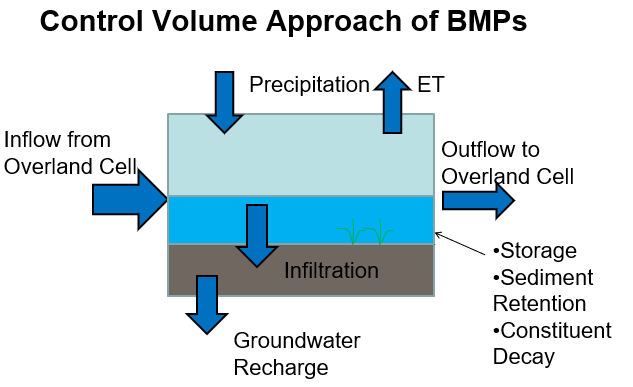Difference between revisions of "Surface Water Routing:Overland Routing with BMPs"
(Created page with "GSSHA has the ability to simulate sub-grid scale best management practice features. These are considered point features that alter the hydrology of the cell they are in. ==5....") |
|||
| Line 5: | Line 5: | ||
Point models affect the volume and timing of flow, sediment, and constituents. The control volume approach allows a wide range of BMPs to be simulated while using a common approach. | Point models affect the volume and timing of flow, sediment, and constituents. The control volume approach allows a wide range of BMPs to be simulated while using a common approach. | ||
| + | [[File:BMP_Control_volume.jpg]] | ||
| + | |||
==5.9.2 Including BMPs in a GSSHA Project== | ==5.9.2 Including BMPs in a GSSHA Project== | ||
To include BMPs in a project, 1) include the OV_BMP card in the project file and 2) include the BMP table in the mapping table file. | To include BMPs in a project, 1) include the OV_BMP card in the project file and 2) include the BMP table in the mapping table file. | ||
| + | |||
<noinclude> | <noinclude> | ||
{{Nav|Nav5}} | {{Nav|Nav5}} | ||
</noinclude> | </noinclude> | ||
Revision as of 02:23, 2 October 2023
GSSHA has the ability to simulate sub-grid scale best management practice features. These are considered point features that alter the hydrology of the cell they are in.
5.9.1 Simulating BMPs in GSSHA
Point models of small scale features are simulated in GSSHA as part of a sub-grid BMP Calculator. They are included as a point solution within a grid cell (or other discrete unit). The Point solution is added to the solution at the grid cell to get the total cell response.
Point models affect the volume and timing of flow, sediment, and constituents. The control volume approach allows a wide range of BMPs to be simulated while using a common approach.

5.9.2 Including BMPs in a GSSHA Project
To include BMPs in a project, 1) include the OV_BMP card in the project file and 2) include the BMP table in the mapping table file.
GSSHA User's Manual
- 5 Surface Water Routing
- 5.1 Channel Routing
- 5.2 Overland Flow Routing
- 5.3 Channel Boundary Conditions
- 5.4 Overland Boundary Conditions
- 5.5 Embankments
- 5.6 Overland/Channel Interaction
- 5.7 Introducing Discharge/Constituent Hydrographs
- 5.8 Overland Routing with Snow
- 5.9 Overland Routing with BMPs